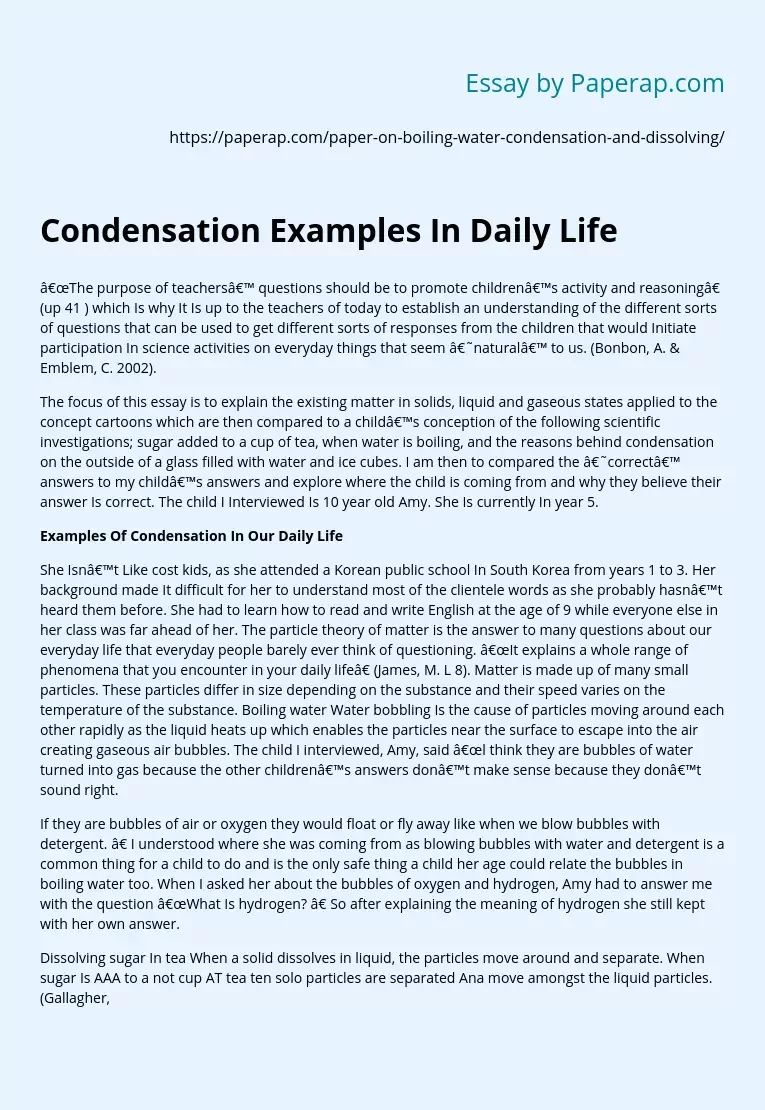Condensation Examples In Daily Life
“The purpose of teachers’ questions should be to promote children’s activity and reasoning” (up 41 ) which Is why It Is up to the teachers of today to establish an understanding of the different sorts of questions that can be used to get different sorts of responses from the children that would Initiate participation In science activities on everyday things that seem ‘natural’ to us. (Bonbon, A. & Emblem, C. 2002).
The focus of this essay is to explain the existing matter in solids, liquid and gaseous states applied to the concept cartoons which are then compared to a child’s conception of the following scientific investigations; sugar added to a cup of tea, when water is boiling, and the reasons behind condensation on the outside of a glass filled with water and ice cubes.
I am then to compared the ‘correct’ answers to my child’s answers and explore where the child is coming from and why they believe their answer Is correct.
The child I Interviewed Is 10 year old Amy. She Is currently In year 5.
Examples Of Condensation In Our Daily Life
She Isn’t Like cost kids, as she attended a Korean public school In South Korea from years 1 to 3. Her background made It difficult for her to understand most of the clientele words as she probably hasn’t heard them before. She had to learn how to read and write English at the age of 9 while everyone else in her class was far ahead of her. The particle theory of matter is the answer to many questions about our everyday life that everyday people barely ever think of questioning.
“It explains a whole range of phenomena that you encounter in your daily life” (James, M. L 8). Matter is made up of many small particles. These particles differ in size depending on the substance and their speed varies on the temperature of the substance. Boiling water Water bobbling Is the cause of particles moving around each other rapidly as the liquid heats up which enables the particles near the surface to escape into the air creating gaseous air bubbles. The child I interviewed, Amy, said “l think they are bubbles of water turned into gas because the other children’s answers don’t make sense because they don’t sound right.
If they are bubbles of air or oxygen they would float or fly away like when we blow bubbles with detergent. ” I understood where she was coming from as blowing bubbles with water and detergent is a common thing for a child to do and is the only safe thing a child her age could relate the bubbles in boiling water too. When I asked her about the bubbles of oxygen and hydrogen, Amy had to answer me with the question “What Is hydrogen? ” So after explaining the meaning of hydrogen she still kept with her own answer.
Dissolving sugar In tea When a solid dissolves in liquid, the particles move around and separate. When sugar Is AAA to a not cup AT tea ten solo particles are separated Ana move amongst the liquid particles. (Gallagher, R. & Ingram, P. Polo-11)The sugar in the cup of tea isn’t as heavy as it is separately, but it hasn’t disappeared into thin air either. For this science experiment Amy said “the sugar in the tea will be same weight as tea without sugar because if the sugar is in water it doesn’t weigh much.
Like when we carry each other in a swimming pool they are really light. She didn’t really understand this one as well as the previous experiment, but I noticed she relates the experiments to what she has learnt from previous experiments in every day life. Condensation The condensation on the outside of a glass occurs when solid water (ice) and cold water have been introduced to a room temperature glass. The condensation is the solid water melting, cooling down the glass.
Amy had to ask me what water vapor meant, and ended up with the conclusion that, “the water vapor in the air has earned into drops of water on the glass because the air around us is trying to keep everything at the same temperature so it tries to warm it up. ” Again she went through the other answers first, and mentioned they didn’t make sense. I believe she made up the reason behind her answer because she isn’t very knowledgeable with her science concepts. Vive discovered each child has a different learning rate and that there are different intelligence levels of one age group.
There is the ‘generalized’ 10 year old, but who’s o say they haven’t been living overseas in Asia for the past 4 years and have an understanding of only the basic science concepts. In conclusion, I have discovered that not all children are amongst the same intelligence level as the rest of their age group, as each child has its different backgrounds and beliefs which can vary their progress in learning. I found it interesting that Amy related most of her answers to examples in her everyday life that she could relate too. This made my Job of understanding where her answers had come from a lot easier.
Condensation Examples In Daily Life. (2019, Dec 05). Retrieved from https://paperap.com/paper-on-boiling-water-condensation-and-dissolving/

